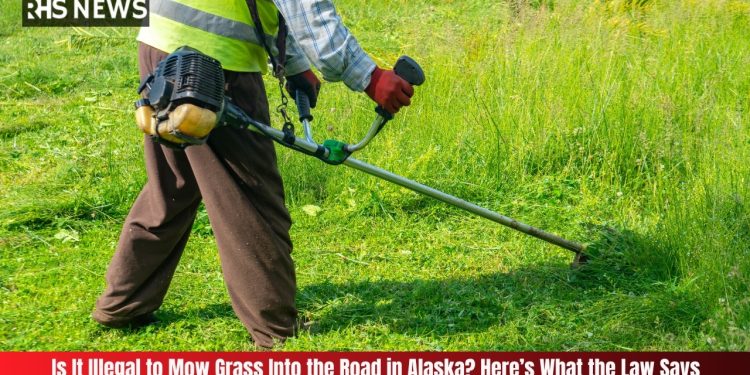In Alaska, where vast landscapes and rugged terrains define daily life, maintaining a tidy yard might seem like a simple chore. However, when grass clippings end up scattered across roadways, it raises questions about legality, safety, and environmental impact.
This article explores whether mowing grass into the road violates state or local laws, drawing on relevant statutes and real-world implications to provide clarity for homeowners and landscapers alike. With Alaska’s highways seeing over 2.5 million registered vehicles annually, understanding these regulations helps prevent unintended violations and promotes safer communities.
Understanding Alaska’s Littering Laws
Alaska’s legal framework treats grass clippings as potential litter when they encroach on public spaces like roads. The state’s primary statute, Alaska Statutes § 46.06.080, prohibits littering on public or private property and in waters, explicitly requiring vehicles to prevent litter from escaping. This broad definition encompasses yard waste, including grass clippings, if they are deposited in ways that could harm public thoroughfares.
Complementing this, the Alaska Administrative Code 13 AAC 02.530 bans throwing, depositing, or allowing litter such as garbage, glass, nails, or other debris upon highways or vehicular areas. Grass clippings fall under this category when they create hazards, as they can accumulate and obstruct visibility or drainage. In urban areas like Anchorage, municipal codes reinforce these rules; for instance, Anchorage Municipal Code 9.36.100 prohibits dropping injurious materials on streets and mandates immediate removal. These laws stem from a need to protect public safety, with enforcement often handled by local police or environmental agencies.
Violations are typically classified as infractions for small amounts, escalating to misdemeanors if debris exceeds five pounds. Fines can range from $100 to $1,000, depending on the jurisdiction, and repeat offenders may face community service or higher penalties. According to the National Conference of State Legislatures, Alaska aligns with 49 other states in penalizing littering, emphasizing prevention over punishment.
State vs. Local Regulations on Yard Waste
While state laws provide a baseline, Alaska’s municipalities often enact stricter ordinances tailored to local conditions. In Anchorage, the largest city with over 288,000 residents, the trash handling ordinance defines yard waste like grass clippings as non-putrescible solid waste that must be contained to avoid public nuisance. Blowing or allowing clippings to enter streets violates this, with fines starting at $100 and potentially reaching $500 for non-compliance.
In smaller communities like Kodiak, Chapter 7.32 of the municipal code explicitly forbids discarding litter, including organic debris, on public or private property. Palmer’s landscaping requirements under PMC 17.64.080 mandate buffers along streets to contain yard materials, indirectly prohibiting spillover into roads. Wasilla permits burning yard debris under controlled conditions but prohibits deposition on roadways, highlighting a preference for on-site management.
The Alaska Department of Transportation and Public Facilities (DOT&PF) oversees highways, with guidelines in the Highway Maintenance and Operations Handbook requiring prompt debris removal to maintain safe conditions. Local variations arise due to Alaska’s diverse geography; rural boroughs like Fairbanks North Star may focus on wildlife impacts, while coastal areas prioritize stormwater protection. Overall, no statewide statute singles out grass clippings, but they are uniformly treated as prohibited debris under anti-littering provisions.
Safety Concerns with Grass Clippings on Roads
Grass clippings pose significant risks, particularly in Alaska’s variable weather where wet roads amplify dangers. Composed of about 85% water, clippings create a slippery surface akin to black ice, reducing tire traction and endangering drivers, cyclists, and motorcyclists. Nationally, road debris contributes to thousands of accidents yearly; in Michigan, for example, debris-related crashes accounted for 0.1% of all incidents from 1997-2001, with higher injury rates than average.
In Alaska, where motorcycle fatalities averaged 15 per year from 2015-2020 according to DOT&PF data, such hazards are acute. Clippings can obscure lane markings or accumulate in curves, forcing evasive maneuvers that lead to collisions.
A 1999 Arizona study, applicable by analogy, found debris caused 0.07% of statewide accidents, with zero fatalities in one county over eight years, but Alaska’s harsher conditions— including snowmelt and high winds—could elevate risks. Environmental factors compound this; clippings block storm drains, contributing to flooding in low-lying areas like Juneau.
Motorcyclists are especially vulnerable, as clippings disrupt the critical contact patch between tires and pavement. Experts recommend slowing down or changing lanes to avoid patches, but in high-traffic zones like the Glenn Highway, this increases crash potential. Homeowners unaware of these dangers often cite convenience, yet simple practices like bagging clippings prevent most incidents.
Potential Legal Consequences
If caught allowing grass clippings to enter Alaska roads, individuals face straightforward penalties under littering statutes. For minor infractions, such as small amounts from residential mowing, fines typically range from $250 to $500, as seen in Anchorage enforcement. Misdemeanor charges apply for larger deposits or if hazards result, carrying up to six months imprisonment and $1,000 fines per Alaska Statutes § 46.06.080.
Liability extends beyond fines if accidents occur. In cases where clippings contribute to crashes, the property owner or landscaper could be sued for negligence, facing civil damages for injuries or property loss. For instance, if a motorcyclist skids on clippings and sustains harm, West Virginia’s similar code (analogous to Alaska’s) holds the depositor accountable. Insurance claims may rise, with premiums increasing by 20-30% for at-fault debris incidents nationally.
Enforcement varies; rural areas rely on complaints to the Department of Environmental Conservation, while urban patrols by municipal code officers issue citations. In 2023, Alaska recorded over 1,200 littering violations statewide, per DEC reports, underscoring growing scrutiny. Repeat violations trigger enhanced penalties, including mandatory cleanup education programs.
Best Practices for Lawful Lawn Maintenance
To stay compliant, Alaskans should adopt proactive habits. Use mulching mowers that keep 70-80% of clippings on the lawn, reducing waste by up to 40% and enriching soil naturally. For excess, bag clippings and dispose via curbside pickup or composting; Anchorage accepts them as rubbish in designated bins.
Sweep or blow clippings back onto property immediately after mowing, avoiding street blowers that propel debris outward. In sloped yards common in Alaska, install berms or gravel strips along road edges to contain runoff. The Composting Council recommends home piles for organic waste, turning clippings into nutrient-rich soil amendments while avoiding disposal fees.
Schedule mowing during dry weather to minimize slippage risks, and educate landscapers on local codes. DOT&PF suggests weekly inspections near highways. These steps not only ensure legality but also support Alaska’s environmental goals, reducing the 500,000 tons of annual yard waste entering landfills statewide.
Environmental and Community Impacts
Beyond legality, grass clippings affect Alaska’s ecosystems. When washed into waterways, they contribute to nutrient overload, fostering algal blooms that harm salmon habitats vital to the state’s $5.8 billion fishing industry. In urban streams like those in Anchorage, clippings exacerbate pollution, with studies showing yard waste accounts for 15-20% of non-point source runoff.
Communally, unchecked debris fosters neighbor disputes and strains municipal resources; cleanup costs Anchorage $2 million yearly for street maintenance. Promoting awareness through local campaigns, like those by the Alaska Clean Water Initiative, encourages sustainable practices. By containing clippings, residents help preserve road integrity, vital for Alaska’s 5,500 miles of paved highways serving remote communities.
Conclusion
Mowing grass into Alaska roads is indeed illegal under broad anti-littering laws, with state statutes and local ordinances prohibiting such debris to safeguard public welfare. While penalties focus on deterrence, the real impetus lies in preventing accidents that claim lives amid the Last Frontier’s challenging drives. By embracing responsible practices, Alaskans can maintain pristine yards without compromising safety or the environment. For specific locales, consulting municipal codes ensures full compliance in this land of wide-open spaces.










